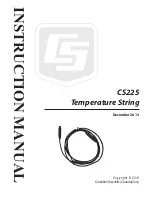
HANBAY Inc
User Manual MCx-xxxDC-2.00
Page 5 of 7
www.hanbayinc.com
Rev.2019.1
1 800 315 4461
Torque Settings:
Effect of power settings:
To accommodate different valves and other applications with different torque requirements, the actuator can be
set to apply different torque on the valve stem when in the seating mode. Please see table on pg. 4 to select the
power setting that is right for your application.
The actuator will use 100% of available torque to try and reach maximum speed. Current drawn will be limited
proportionally to the DiP setting applied actuator will automatically slow down and deliver the maximum available
torque for a given “Permanent Power Setting”.
Appendix
Calibration
The calibration routine can be initiated by toggling DIP 9. This will cause the actuator to go through a series of
movements to determine the proper open and closed position for the mounted valve. This function is useful if the
actuators output gear was manually rotated while the actuator is powered down and can’t properly close and open.
Troubleshooting:
Upon noticing a problem, your first step should almost always be to recalibrate the actuator by switching DIP 9 on
then off, all while the actuator is powered. This alone can solve basic problems. See above for instructions.
If the actuator does not move, try following these steps:
1)
Re-calibrate the actuator. This will move the actuator regardless of what signal it is receiving.
2)
A sticking valve may be the problem. Remove the valve from the actuator, and re-test the actuator.
3)
Remove power. Re-check the wiring and the power/signal apparatus. Power actuator, and re-calibrate.
If the problem persists, please call Hanbay for technical support.
Note: 66% setting and 100% setting may alter duty cycle:
-
When operating above 66% power, Duty cycle is reduced to 50% - 25% maximum. At these
levels, the electronics produce more heat which must be dissipated (depending on environmental
temperature)

























